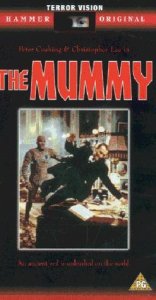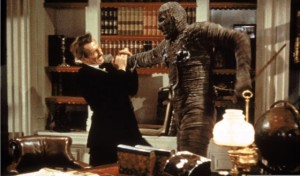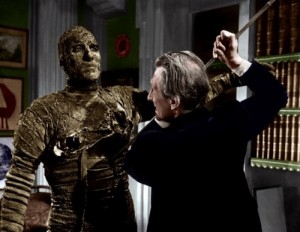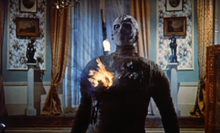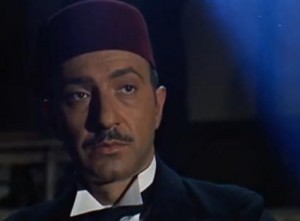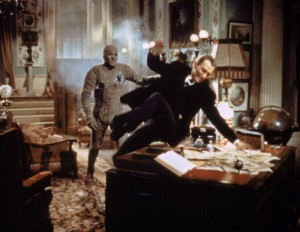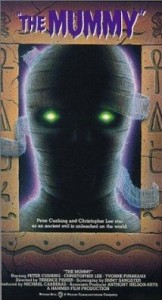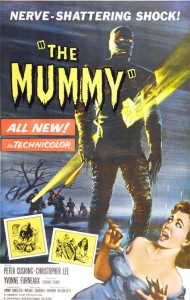The Mummy **** (1959, Peter Cushing, Christopher Lee, Yvonne Furneaux) – Classic Movie Review 499
‘Torn from the tomb to terrify the world!’ Peter Cushing and Christopher Lee star in Hammer Films’ 1959 British horror film The Mummy.
‘Torn from the tomb to terrify the world!’
The 1959 British horror film The Mummy stars Peter Cushing and Christopher Lee, along with Yvonne Furneaux, Eddie Byrne, Felix Aylmer, Raymond Huntley and George Pastell. It is written by Jimmy Sangster and produced by Michael Carreras and Anthony Nelson Keys for Hammer Film Productions.
Legendary horror director Terence Fisher’s 1959 version of the 1932 Boris Karloff vintage chiller The Mummy for Hammer Studios is a pretty good reworking of the story, with a capable screenplay by Jimmy Sangster that also includes ideas from The Mummy’s Hand (1940) and The Mummy’s Tomb (1942), deriving its plot and characters from these two 1940s Universal films.
Actually, though it is a nominal remake of The Mummy (1932), it is in substance a joint remake of The Mummy’s Hand (1940) and The Mummy’s Tomb (1942). Sangster takes only the character name Joseph Whemple, the use of a sacred scroll and some plot elements from the 1932 version.
Felix Aylmer and Peter Cushing star as Stephen and John Banning, father and son Egyptologists whose 1890s archaeological dig unexpectedly brings the bandaged monster Kharis the Mummy (Christopher Lee) back to life. He desperately needs to protect the 4,000-year-old tomb of his Queen Ananka (Yvonne Furneaux) and destroy those responsible for its desecration.
One by one the members of the party of archaeologists who have discovered the tomb are brutally murdered. Cushing’s wife Isobel Banning (also played by Furneaux) turns out to be a dead ringer for Kharis’s long-dead beautiful paramour. This forces the mostly speechless and tormented monster to defy commands and abduct Isobel for an unknown fate.
Fisher, the director of Dracula (1958) and The Curse of Frankenstein (1957), confidently directs in lurid ‘terrifying’ Eastmancolor/ Technicolor with a sharp eye for atmosphere, shocks and the tale’s Freudian subtext. Cushing puts a fresh spin on his Van Helsing role and, with his weird way of walking and eerie presence, Lee’s near-silent performance is very striking.
The vigorous turns from Cushing and Lee help to make for a dynamic chiller, also nicely populated by British character actor stalwarts Raymond Huntley (as Joseph Whemple), John Stuart (coroner), Michael Ripper (poacher), George Pastell (wicked Egyptian named Mehemet Bey), George Woodbridge (police constable Blake), Denis Shaw (as Mike) and Harold Goodwin (as Pat), who help out lots.
Also in the cast are Eddie Byrne as Inspector Mulrooney, Gerald Lawson as Irish Customer, Willoughby Gray as Dr Reilly, David Browning as Police Sergeant, Frank Sieman as Bill, Stanley Meadows as Attendant, and Frank Singuineau as Head Porter.
The film looks surprisingly good thanks to Jack Asher’s alluring Eastmancolor (processed by Technicolor) cinematography and to the bigger Hammer budget this time of £125,000 (around twice that of The Curse of Frankenstein‘s meagre £65,000), providing the money production designer Bernard Robinson needs to impress. It also sounds good too this time, with the score by Franz Reizenstein. It stands up very well, passing the test of time, with little more than its abrupt ending and Yvonne Furneaux’s unpersuasive performance counting against it.
Hammer having finally caved in and made a deal with Universal Pictures after Dracula (1958) and The Curse of Frankenstein (1957), The Mummy became their first horror film to use parts of Universal’s concepts for remakes. For example, Kharis the Mummy was the name used in Universal’s Mummy films played by Tom Tyler and Lon Chaney Jr.
Felix Aylmer’s character of Professor Stephen Banning and Peter Cushing’s character of John Banning are the same as the ones in The Mummy’s Tomb, which this film resembles much more than the 1932 The Mummy.
Karloff plays a different Mummy character, Imhotep the Mummy, (and Ardeth Bay) in the 1932 The Mummy, though their back stories are practically identical. In the first Kharis film, The Mummy’s Hand (1940), the character of Kharis is played by Westerns film actor Tom Tyler, while the three subsequent films, The Mummy’s Tomb (1942), The Mummy’s Ghost (1944) and The Mummy’s Curse (also 1944), all star Lon Chaney Jr in the role.
Though the iconic image of the Mummy’s face is usually Karloff’s from The Mummy, the Kharis films are responsible for the enduring stereotype of the lumbering, foot-dragging monster. Karloff’s bandaged creation is seen only briefly The Mummy, while Kharis is a major on-screen character in all four follow-up films, and the Kharis movies introduce the idea of tana leaves as integral to the Mummy’s survival.
The runtime is either (original).
It is shot at Bray Studios, Down Place, Oakley Green, Berkshire, England.
The Mummy went on to become the third most successful franchise at Hammer Studios and three Hammer sequels followed, starting with The Curse of the Mummy’s Tomb (1964), followed by The Mummy’s Shroud (1967) and Blood from the Mummy’s Tomb (1971).
The Mummy was triumphantly revived in the CGI effects era of 1999 with The Mummy and its sequels: The Mummy Returns (2001) and The Mummy: Tomb of the Dragon Emperor (2008). Universal rebooted it less successfully in 2017 for The Mummy.
Cushing recalled he suggested the scene where he drives a spear through the Mummy, inspired by the film’s release poster depicting the Mummy with a shaft of light passing through it.
[Spoiler alert] British censorship resulted in cuts to the original more graphic scenes of Kharis’s tongue being cut out and shotgun demise.
The beautiful glass fibre sarcophagus prop created for the film is now in the Perth Museum and Art Gallery.
In October 2013 it was released on Blu-ray and DVD after not being available for 10 years, and shown again on the big screen at the BFI Southbank, London.
© Derek Winnert 2013 Classic Movie Review 499
Check out more reviews on http://derekwinnert.com/

